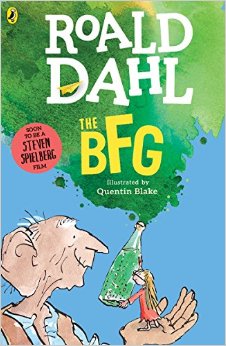 The BFG by Roald Dahl, illustrated by Quentin Blake
The BFG by Roald Dahl, illustrated by Quentin Blake
Farrar, Straus and Giroux, 1982. 978-0374304690
Synopsis: Sophie doesn’t believe in giants….until one night when she happens to see one out the orphanage window. Naturally, the giant kidnaps her and whisks her away to his cave, which really isn’t as bad as it sounds. You see, most giants would have already eaten Sophie whole. But this is the Big Friendly Giant, who blows good dreams into the children’s windows as they sleep. So when the child-eating giants decide that England will be their next buffet, Sophie and the BFG must come up with a srumdidilyumptuous plan to outwit them.
Why I picked it up: It was one of my brother’s favorites when he was in elementary school and it is the only book I remember him reading that made him laugh out loud.
Why I finished it: My brother reads just as voraciously as I do, but somehow we grew up reading very few of the same books. We both read and liked many Roald Dahl books over the years, but this one eluded me for some reason or another. The BFG has the traditional mix of lighthearted and dark moments that are the hallmark of Dahl’s stories, while offering an explanation for whence come our good and bad dreams. What struck me was the element of peril running throughout the story, something that I don’t recall being quite as prevalent in his other works. The reader recognizes that the BFG wants to keep Sophie safe from his child-munching brethren, but there is still a fear that keeps hold of us page after page and chapter after chapter. Will it work? Will the giants discover Sophie? Can this girl and the giant convince the Queen that giants exist so they can save England? Will the BFG be able to eat anything other than snozzcumbers? But the dark is somewhat balanced out by the backward nature of the BFG himself. We see that he is on the outside of the clan, partially because of his refusal to eat “human beans”. We laugh at the notion that he has stolen a child’s schoolbook to be able to learn how to write. We are endeared by his jumbled speech and mixed-up metaphors. Though Sophie tries to set him straight, she eventually accepts that by trying to correct him, the two will merely become more and more confused. Blake’s illustrations add to the quirky nature of the story, drawn in abrupt strokes with heavy lines that still manage to give the characters a realistic quality. It’s a story about the power of sheer determination and the idea that friends come in all shapes and sizes and can be found in the most unlikely places.
Other related materials: Matilda by Roald Dahl; James and the Giant Peach by Roald Dahl; Charlie and the Chocolate Factory by Roald Dahl, illustrated by Quentin Blake; Charlie and the Great Glass Elevator by Roald Dahl, illustrated by Quentin Blake; Danny the Champion of the World by Roald Dahl, illustrated by Quentin Blake; The Witches by Roald Dahl, illustrated by Quentin Blake; Fantastic Mr. Fox by Roald Dahl, illustrated by Quentin Blake; The Twits by Roald Dahl, illustrated by Quentin Blake; Pippi Longstocking by Astrid Lindgren; Charlotte’s Web by E.B. White; Stuart Little by E.B. White; Pax by Sarah Pennypacker
